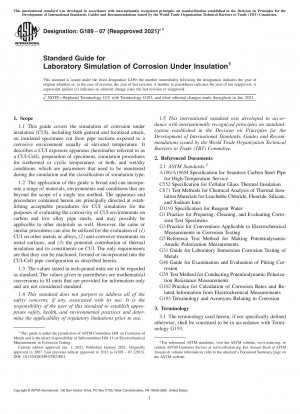ASTM G189-07(2021)e1
Standard Guide for Laboratory Simulation of Corrosion Under Insulation
- Standard No.
- ASTM G189-07(2021)e1
- Release Date
- 2021
- Published By
- American Society for Testing and Materials (ASTM)
- Latest
- ASTM G189-07(2021)e1
- Scope
- 1.1 This guide covers the simulation of corrosion under insulation (CUI), including both general and localized attack, on insulated specimens cut from pipe sections exposed to a corrosive environment usually at elevated temperature. It describes a CUI exposure apparatus (hereinafter referred to as a CUI-Cell), preparation of specimens, simulation procedures for isothermal or cyclic temperature, or both, and wet/dry conditions, which are parameters that need to be monitored during the simulation and the classification of simulation type. 1.2 The application of this guide is broad and can incorporate a range of materials, environments and conditions that are beyond the scope of a single test method. The apparatus and procedures contained herein are principally directed at establishing acceptable procedures for CUI simulation for the purposes of evaluating the corrosivity of CUI environments on carbon and low alloy pipe steels, and may possibly be applicable to other materials as well. However, the same or similar procedures can also be utilized for the evaluation of (1) CUI on other metals or alloys, (2) anti-corrosive treatments on metal surfaces, and (3) the potential contribution of thermal insulation and its constituents on CUI. The only requirements are that they can be machined, formed or incorporated into the CUI-Cell pipe configuration as described herein. 1.3 The values stated in inch-pound units are to be regarded as standard. The values given in parentheses are mathematical conversions to SI units that are provided for information only and are not considered standard. 1.4 This standard does not purport to address all of the safety concerns, if any, associated with its use. It is the responsibility of the user of this standard to establish appropriate safety, health, and environmental practices and determine the applicability of regulatory limitations prior to use. 1.5 This international standard was developed in accordance with internationally recognized principles on standardization established in the Decision on Principles for the Development of International Standards, Guides and Recommendations issued by the World Trade Organization Technical Barriers to Trade (TBT) Committee.
ASTM G189-07(2021)e1 Referenced Document
- ASTM A106/A106M Standard Specification for Seamless Carbon Steel Pipe for High-Temperature Service
- ASTM C552 Standard Specification for Cellular Glass Thermal Insulation
- ASTM C871 Standard Test Methods for Chemical Analysis of Thermal Insulation Materials for Leachable Chloride, Fluoride, Silicate, and Sodium Ions
- ASTM D1193 Standard Specification for Reagent Water
- ASTM G1 Standard Practice for Preparing, Cleaning, and Evaluating Corrosion Test Specimens
- ASTM G102 Standard Practice for Calculation of Corrosion Rates and Related Information from Electrochemical Measurements
- ASTM G193 Standard Terminology and Acronyms Relating to Corrosion*, 2022-08-01 Update
- ASTM G3 Standard Practice for Conventions Applicable to Electrochemical Measurements in Corrosion Testing
- ASTM G31 Standard Practice for Laboratory Immersion Corrosion Testing of Metals
- ASTM G46 Standard Guide for Examination and Evaluation of Pitting Corrosion
- ASTM G5 Standard Reference Test Method for Making Potentiostatic and Potentiodynamic Anodic Polarization Measurements
- ASTM G59 Standard Test Method for Conducting Potentiodynamic Polarization Resistance Measurements
ASTM G189-07(2021)e1 history
- 2021 ASTM G189-07(2021)e1 Standard Guide for Laboratory Simulation of Corrosion Under Insulation
- 2007 ASTM G189-07(2013) Standard Guide for Laboratory Simulation of Corrosion Under Insulation
- 2007 ASTM G189-07 Standard Guide for Laboratory Simulation of Corrosion Under Insulation
